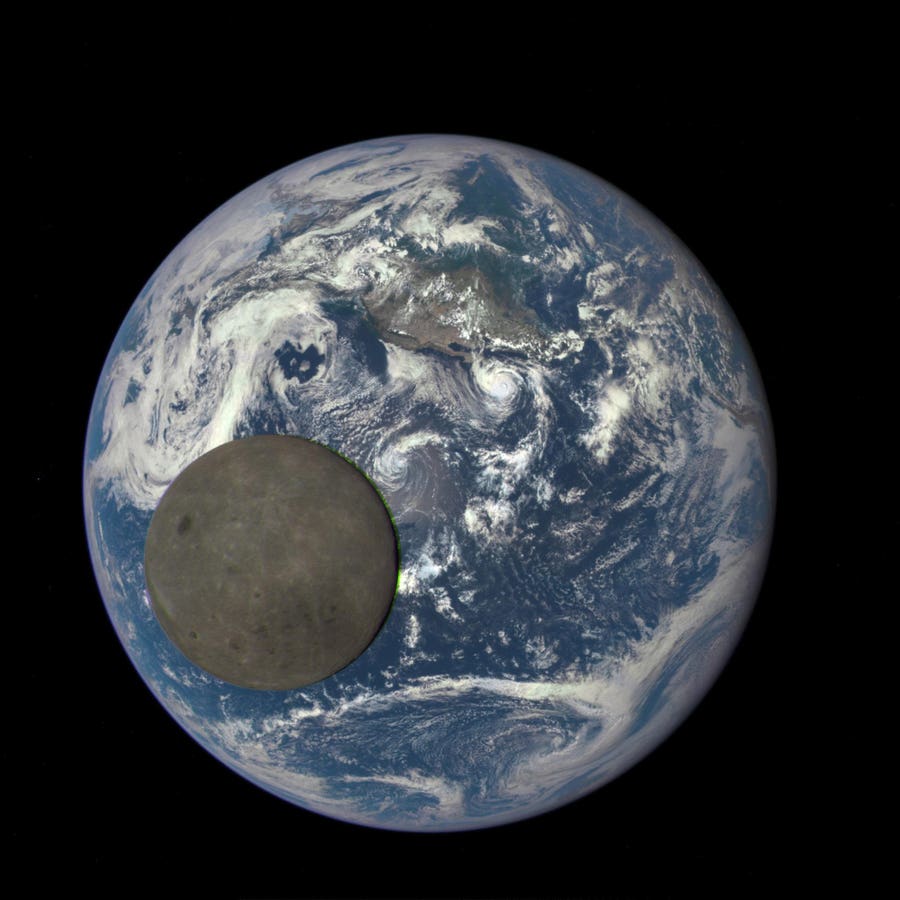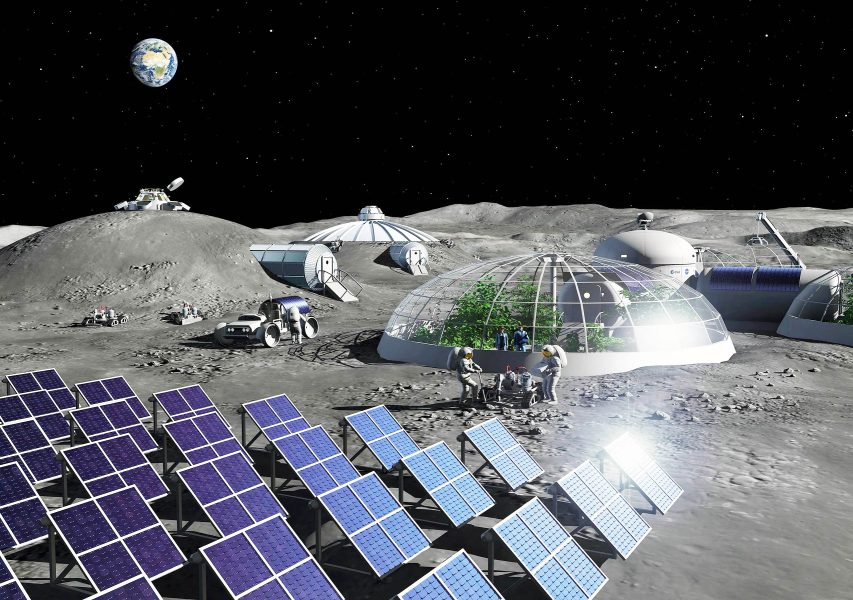Space Robotics Leader Says Humans Will Soon Join Robots On Moon, Mars – Forbes

Colossal super-rockets being produced by billionaires Elon Musk snd Jeff Bezos are set to carry … [+] astronauts across the heavens in a new “Golden Age of Space Exploration” (Photo by NASA via Getty Images)One of the globe’s top designers of space robots says a new “Golden Age of Space Exploration” – spearheaded by the world’s twin Titans of spaceflight – will speed up astronauts joining robotic scouts in trekking around the Moon and Mars.Gigantic new rockets now being tested by spacecraft makers Elon Musk and Jeff Bezos – the planet’s leading hyper-billionaires – are setting the stage for human explorers to sojourn across an expanding realm of off-world outposts, says Kris Zacny, Director of the Exploration Technology Group at Honeybee Robotics.During a virtual roundtable with journalists and space aficionados staged by the Mars Society, Dr. Zacny, who holds a doctorate in geotechnical engineering, with a focus on extraterrestrial drilling and mining, from the University of California Berkeley, sketched out his predictions for the new space epoch being opened by the titanic spacecraft now waiting in the wings.“Folks who love space are the luckiest people on Earth,” Zacny mused during the meetup, hosted by the Mars Society’s Ashton Zeth.“We have two of the wealthiest guys in the world prepared to spend their own money to go to space and change how we explore space and make space habitable,” Zacny says.“They have a combined wealth of 500 billion dollars – half a trillion dollars – and this is their vision.”“This is a golden age of space exploration.”A new generation of gigantic rockets will power astronaut flights to an expanding ring of celestial … [+] outposts. “Transparent Solar System” rendering created by James Reynolds & Sons, London, England around 1860. (Photo by SSPL/Getty Images)“Jeff [Bezos] and Elon [Musk] are prepared … to change humanity forever.”By designing colossal boosters that are rapidly reusable, and could power interplanetary flights ahead, these two Promethean rivals of the NewSpace sector, with their contest to dominate the celestial sphere, could collectively propel expanding waves of spacefarers into the heavens.“Last week a Falcon 9 launched with [the Moon-bound lander] Firefly,” Zacny recounted, “then the next day New Glenn launched for the first time – it was a perfect launch – then Starship launched again.”“We had three different rockets from private companies launching in three consecutive days, and these rockets will be taking humans to the Moon and Mars – so we are lucky.”Blue Origin’s first flight test of its massive New Glenn rocket played out almost flawlessly, while the seventh demo of the Starship – which featured a more advanced version of the super-capsule – ended in a pyrotechnic break-up of the second stage, sparked by SpaceX’s super-speed campaign to perfect the most powerful and technologically sophisticated spacecraft ever to take flight from Planet Earth.Both Blue Origin and SpaceX have been commissioned by NASA to deploy landers to shuttle astronauts from lunar orbit down to the polar region of the Moon in a series of Artemis missions across the second half of the 2020s, and their supercharged rockets will launch those landers.This unfolding phase of advanced rocketry and robotics will set the stage for human bases to expand outward.Kris Zacny has produced an array of groundbreaking studies and books on deploying robots to extraterrestrial outposts to build the foundation for later astronaut missions, for example by constructing H2O reservoirs that could in turn provide oxygen for domed oases on the Martian dunes and rocket fuel for Mars-Earth space odysseys.His team at Honeybee Robotics Exploration Systems has already designed robotic instruments that have sped across the solar system, including on the Mars Phoenix lander, the Mars Exploration Rovers Spirit and Opportunity, and the Perseverance rover, which is now exploring the ghosts of lakes and rivers that once animated the orange-red dune-covered planet.Honeybee’s breakthrough technologies are also set to touch down on the netherworld-like moon Titan, revolving around the fantastical rings of Saturn.One of Honeybee’s future robots will fly across the otherworldly lakes and skies of Saturn’s moon … [+] Titan, shown in this painting by Rick Guidice at NASA. (Photo by Space Frontiers/Space Frontiers/Getty Images)Another Honeybee invention, designed to collect samples of moondust on the lunar surface, is now on its way to the silvery orb, and its Trident drill, aimed at potentially excavating water around the lunar South Pole, is still searching for a White Knight rocket to blast it off to the Moon, Zacny told me during the Mars Society’s virtual conference.When I asked Dr. Zacny about the fate of the Trident, part of the VIPER mission that was once slated to help prospect for ice that survived – potentially for billions of years – hidden away in the Moon’s eternally shadowed craters, he was surprisingly upbeat.NASA commissioned leading American scientists and roboticists to design and develop a roving science lab, with spectrometers to detect ice and the Trident to drill for it, as part of pivotal plan to begin amassing ice for later astronaut missions and habitats.Then, when researchers were just about to cross the finish line on perfecting the VIPER lab last summer, NASA’s leaders abruptly cancelled the $433-million project, stating that “cost increases” and “delays to the launch date” impelled the agency to “stand down on the mission,” even though these same negative factors plagued a host of NASA science missions as the COVID pandemic hit the world.“Moving forward, NASA is planning to disassemble and reuse VIPER’s instruments and components for future Moon missions,” the leadership then in power stated, but the space agency held out a slight chance of a reprieve for the lab if a commercial American or international partner offered to deploy “the existing VIPER rover system at no cost to the government.”“VIPER is finished in terms of development of the rover,” Zacny told me. “It went through all the environmental testing and it passed with glowing colors. So it’s ready.”“What we are looking for is a ride to the Moon – the rocket.”“Once we start flying these big missions – once Blue Origin’s Mark 1 and and Mark 2 [lunar] landers start flying – once the Starship starts flying to the Moon – these have enormous capacity – enormous.”On a Starship or New Glenn flight, he adds, “VIPER would be just one of the payloads – not the only payload.”“I’m 100-percent sure we’re going to be flying to the Moon.”Although Blue Origin acquired Honeybee Robotics three years ago, the robot maker has operated fairly autonomously, and Kris Zacny delves out equal praise to Blue and to SpaceX.He has even teamed up with two of SpaceX’s top engineers, along with a constellation of vanguard American space scholars, to sketch out how the leading-edge Starship could open an astonishing phase of human settlements across the solar system.In a joint study titled “Accelerating Martian and Lunar Science through SpaceX Starship Missions,” Zacny and his SpaceX confrères state: “This two-stage vehicle (Super Heavy first stage and Starship as the second stage) is fully reusable and can transport payloads to Earth orbit, the Moon, and Mars, along with being able to support a number of other missions including to Venus, asteroids, or elsewhere in the Solar System. ““The first set of Starships launched to Mars will be uncrewed and are intended to demonstrate the capability to successfully launch from Earth and land on Mars with human-scale lander systems.”These autonomously piloted ships will “provide the opportunity to deliver significant quantities of cargo to the surface in advance of human arrival.”SpaceX founder Elon Musk says he aims to loft a flotilla of unmanned Starships to Mars next year, … [+] with an astronaut launch set for 2028 (Marie D. De Jesús/Houston Chronicle via Getty Images)Teams of autonomous robots flown to Mars on this first fleet of Starships could help set up an astronaut base by positioning “equipment for increased power production, water extraction, LOX/methane production [for rocket fuel], pre-prepared landing pads, radiation shielding, dust control equipment [and] exterior shelters for humans.”Elon Musk told his 200 million followers on X last summer that he aims to launch five unmanned Starships to Mars in late 2026, when the next Earth-Mars orbital transfer window opens, and the first Mars-bound astronauts in 2028 – for a Starship landing in the second half of 2029.Ever since launching SpaceX, Musk has said its core mission is to create a second foundation for human civilization on Mars, with the near-term goal of fostering the Red Planet’s first cosmopolis, of one million human Martians, within two decades of lofting the initial flotillas of interplanetary Starship capsules.“An ultimate objective of SpaceX is to develop self-sustaining cities on Mars,” Zacny and his SpaceX co-authors state, “and current SpaceX architecture plans call for multiple Starship flights to be launched to Mars at every launch opportunity (~2 years).”While Mars is the primary target, they add, “flights to the Moon do provide the opportunity to test and demonstrate Starship systems closer to Earth prior to the longer journey to Mars.”“More frequent flights to the Moon than to Mars are feasible due to orbital dynamics,” they add, “and thus significant capabilities can be developed and tested at the Moon prior to Mars missions.”During the Mars Society gathering, Zacny predicted the next stage of human spaceflight missions would target the Earth’s ancient black and silver satellite: “We’re going to the Moon first for many reasons.”Yet he adds: “I’m really hopeful we’ll go to Mars this decade.”The venue Zacny chose to outline his predictions on the changing destiny of humans in space – the Mars Society – was created a quarter-century ago by Robert Zubrin, who is likely to be chronicled by historians of the future as the master architect of the campaign to reshape Mars in the Earth’s image.While NASA and other space agencies have perennially cast Mars as a target destination for human landings in the distant future, Zubrin has scripted a series of books, including The Case for Mars, that outline how this generation can deploy current rockets and robots to touch down on Mars and begin terraforming the now-frozen planet.Mars Society founder Robert Zubrin aims to remake the Red Planet in the Earth’s image, as a … [+] proto-Eden for a new branch of civilization. AFP PHOTO/ ESA /Illustration by Medialab (Photo credit should read -/AFP via Getty Images)Zubrin envisions that inside massive geodesic domes – assembled by robots and pressurized with oxygen captured on Mars – the first human colonies and glasshouse gardens will start spreading across the dunes even as geo-engineers begin warming the entire planet, restoring its ocean and atmosphere while building a proto-Eden to host a new branch of civilization.Kris Zacny paid homage to the founder of the Mars Society during his talk, and said reading one of Zubrin’s books while a graduate student in California changed the trajectory of his life, setting him on track to design robots bound for Mars.One Community. Many Voices. Create a free account to share your thoughts. Our community is about connecting people through open and thoughtful conversations. We want our readers to share their views and exchange ideas and facts in a safe space.In order to do so, please follow the posting rules in our site’s Terms of Service. We’ve summarized some of those key rules below. Simply put, keep it civil.Your post will be rejected if we notice that it seems to contain:User accounts will be blocked if we notice or believe that users are engaged in:So, how can you be a power user?Thanks for reading our community guidelines. Please read the full list of posting rules found in our site’s Terms of Service.






